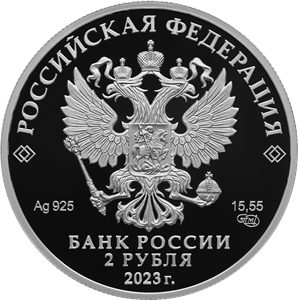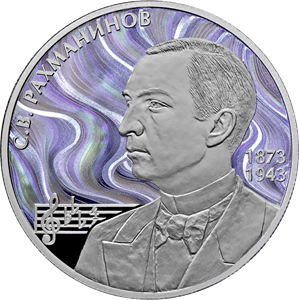Composer Sergei Rachmaninoff, the 150th Anniversary of his Birth
Obverse
a relief image of the National Coat of Arms of the Russian Federation and a semicircular inscription above it along the rim: ‘РОССИЙСКАЯ ФЕДЕРАЦИЯ’ (RUSSIAN FEDERATION) framed with paired diamonds on both sides, under the coat of arms there are the chemical symbol of the metal and fineness on the left and fine metal content and the mint trade mark on the right, at the bottom in the centre, in three lines, there is an inscription: ‘БАНК РОССИИ’ (BANK OF RUSSIA), the coin denomination: ‘2 РУБЛЯ’ (2 RUBLES), and the year of issue: ‘2023 г.’ (2023).
Reverse
relief images of Sergei Rachmaninoff’s portrait and a stave against a stylised background of a composition of wavy iridescent lines with the effect of light interference; the relief inscription ‘С.В. РАХМАНИНОВ’ (SERGEI RACHMANINOFF) on the upper left; and the years of the composer’s birth and death ‘1873’ and ‘1943’ in two lines on the right.
Authors
Designers: E.V. Kramskaya (obverse, reverse), A.V. Baklanov, National Artist of Russia (reverse).
Sculptor: A.A. Dolgopolova (obverse, reverse).
Mint: Saint Petersburg Mint (СПМД).
Edge: 195 corrugations.
Discover more
Sergei Rachmaninoff (1873–1943) is a pianist and composer who became a recognised symbol of Russian music worldwide.
He graduated from the Moscow Conservatory as a pianist and composer winning a Great Gold Medal for his one-act opera Aleko which he wrote for his final exam. Tchaikovsky who examined the young pianist praised the opera and recommended it for staging at the Bolshoi Theatre.
Soon, young Rachmaninoff became a crowd favourite in Moscow appreciated as a talented pianist, composer and conductor. Unfortunately, in 1897, the musician was affected by a real failure: his Symphony No. 1 was poorly performed by composer Alexander Glazunov in Petersburg. The reviews were very negative. Rachmaninoff’s innovative work was rejected by both critics and the audience.
A new phase in his life and career started in 1901 when the composer completed his Piano Concerto No. 2. With this concerto, Rachmaninoff regained the status of a world-known Russian musician: he was writing a lot of music, performed as a conductor, and toured with his concerts across Europe, the US, and Canada. The composer became the conductor at the Bolshoi Theatre where he was responsible for the entire Russian opera repertoire for several seasons and headed the Arts Council of the Russian Music Publisher.
Shortly after the Russian Revolution of 1917, Rachmaninoff, together with his family, left Russia almost without any money. The revolution, the destruction of the Russian Empire, and the disruption of traditions became a real tragedy for him. However, Rachmaninoff was to support his family and repay his debts, and he resumed his performances as a pianist. He won over the European audience, and then went to the US in 1918 where he continued his concerts. Critics and the audience appreciated him as one of the greatest composers and conductors of the epoch.
Rachmaninoff was unable to write music for nearly ten years after leaving Russia. It was not until 1926–1927 when he wrote his Piano Concerto No. 4 and Russian songs.
His last major work, the Symphonic Dances, was composed in his later years and is still considered by musicologists to be one of Rachmaninoff’s best works.
Source: https://www.culture.ru


